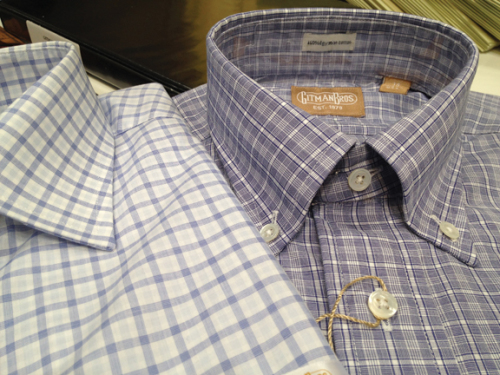Merchandising Furnishings: You’re Doing it Wrong

Gitman’s Dana Dean and John Minahan are visiting stores on a crusade to change the way specialty retailers sell shirts and ties.
What if you realized that everything you were doing with the way you display and sell shirts and ties was wrong? That you and every other specialty store retailer had slowly succumbed to a handful of counterproductive trends in merchandising that may be hindering your furnishings business? That’s the story John Minahan and Dana Dean told me recently.
“The moment a guy walks into a store, a timer starts,” says Dean, a former Nordstrom manager who spends a lot of time on the road training and doing trunk shows. “How do you improve your sales in that time? Better service, better fit. Measure the guy.”
Gitman’s solution for retailers is for them to measure shirt customers immediately instead of merely asking them their size, and to guide them to an area where dress shirts are merchandised by size (not style) and divided into two sections: one for dress shirts traditionally worn with suits and another for dress shirts that can be worn as sport shirts—or as Minahan has rebranded them, “exact-fit sport shirts.”
Minahan’s reasoning is sound: so many men are wearing patterned dress shirts as sport shirts because they fit better and offer more versatility.
“Once you get the size, you could show him the exact-fit sport shirt area of the dress furnishings and he could buy three or four shirts in his exact size before you even take him to the sport shirts,” he explains. “These simple gingham and Tattersall shirts, which are what most men like to wear most of the time, tend to under achieve in a sportswear presentation because there are so many highly designed sport shirts and the emphasis goes away from the simple checks and stripes, which nine out of ten men like to wear under a sportcoat.”
And further, why merchandise neckwear by just brand, or by color? “Almost everybody in the neckwear business says it’s trending down and they all have the same merchandising philosophy, which is what I call the sea of crap,” Minahan says bluntly. “They don’t give any distinction to new widths or suit ties or classic American ties that go with sportcoats. They don’t create areas of energy with neckwear, they create one area of negative energy. A customer looks at that, gets confused, and says, ‘I have enough ties,’ or ‘I don’t wear ties anymore.’”
The solution is to make sure the sartorial ties are displayed with the sartorial dress shirts, and that the seasonal ties in say, wool or linen, are displayed near the chambray dress shirts. Give the neckwear displays a real point of view, show the customer how to wear them.
Coachman Clothiers, a 3,800 sq. ft. men’s store in Knoxville, Tenn., has taken much of Gitman’s advice, but not all of it. The store has recently simplified its furnishings vendor matrix, cutting many brands and keeping Gitman and Circle of Gentlemen for dress shirts, and Gitman, Drake’s and Geoff Nicholson for neckwear. Ironically, before Dana Dean convinced Coachman to try selling dress shirts as exact-fit sport shirts, they’d been asking their dress shirt vendors to label shirts S/M/L. “I thought it would help us,” admits Jeffrey Openshaw. “It worked in a way, but it was so dang complicated. The exact-fit sport shirt method has really increased our sales—not only our dress shirt sales, but our sport shirt sales—by almost 40 percent since we started this.” And they do carry traditional sport shirts, from brands like Bugatchi and Mine Apparel.
“When a guy comes in and asks us about dress shirts, we don’t ask him his size. Our sellers just grab a tape. Guys think they know their size, but the majority of the time, they’re wrong. We can then show a dozen shirts in his exact size and tell him that four of them are staples that every guy needs to have in his wardrobe. And when you tell him that they’re sport shirts, not just dress shirts, it’s a win-win.”
But Coachman stops short of merchandising shirts by size. “I don’t think it looks good!” laughs Openshaw. “From a functionality standpoint, I get the point, but I still think even a guy in a hurry needs to see something visually appealing. When I see shirts mixed and matched by size, it just doesn’t tell a story.”
Ultimately, it’s about approaching shirts and ties differently. While men aren’t required to wear ties anymore, there are plenty of occasions when they’re appropriate. By acknowledging this in the store, you’ll sell more of them. Exploit the fact that men are wearing dress shirts from work to evening, with and without ties. Sell your customers on the basics and take advantage of shirt vendors—like Gitman, Eton and others—that have robust in-stock programs.










Comments are closed.